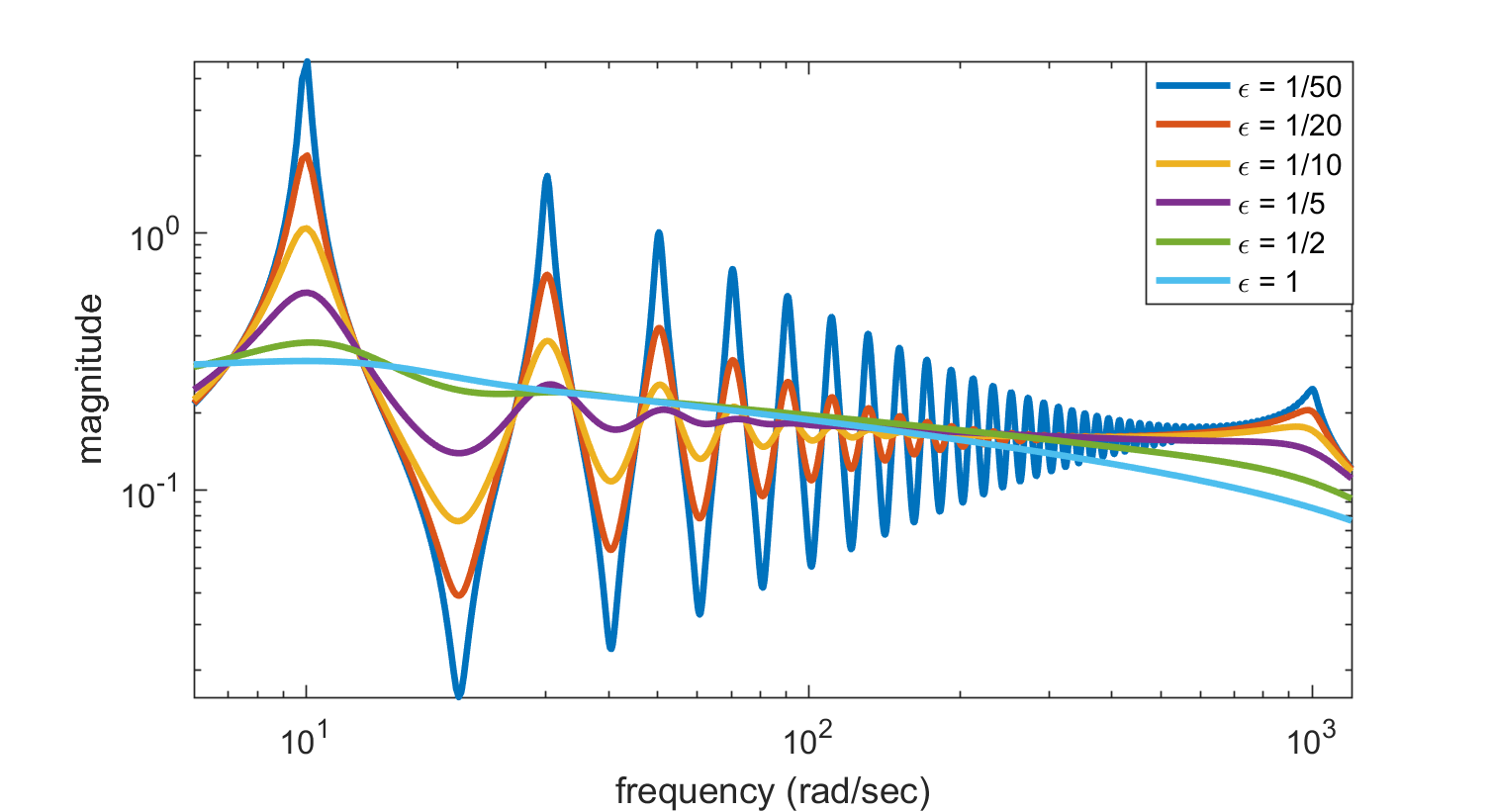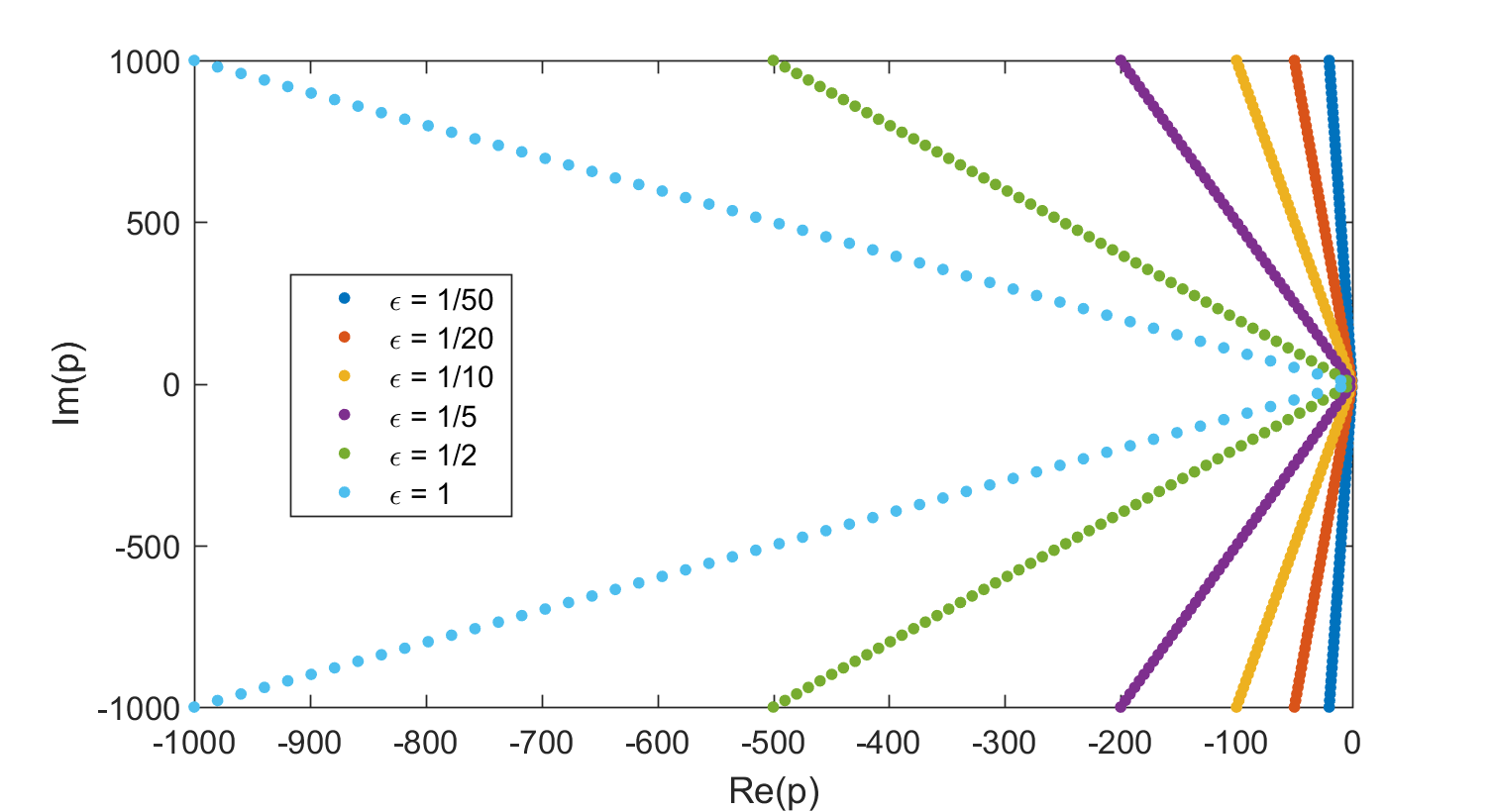Introduction
On this page you will find a synthetic parametric model for which one can easily change system order, parameter values, poles, residues. The decay of Hankel singular values can also be changed indirectly by changing the value of the parameter.
System description
The parameter  scales the real part of the system poles, that is,
scales the real part of the system poles, that is,  .
For a system in pole-residue form
.
For a system in pole-residue form
we can write down the state-space realisation  with
with
Notice that the system matrices have complex entries.
For simplicity, assume that  is even,
is even,  , and that all system poles are complex and ordered in complex conjugate pairs, i.e.
, and that all system poles are complex and ordered in complex conjugate pairs, i.e.
and the residues also form complex conjugate pairs
Then a realization with matrices having real entries is given by
with ![A_{\varepsilon,i} = \left[\begin{array}{cc} a_i& 0 \\ 0 & a_i \end{array}\right]](/morwiki/images/math/c/4/d/c4daf85733e144db5528fb1a97dcc3b1.png) ,
,
![A_{0,i} = \left[\begin{array}{cc} 0& b_i \\ -b_i & 0 \end{array}\right]](/morwiki/images/math/9/c/e/9cefed461140230838eec45e4654af4a.png) ,
,
![B_{i} = \left[\begin{array}{c} 2 \\ 0 \end{array}\right]](/morwiki/images/math/1/6/d/16d6f95252fffc0c7217cb71546f9dff.png) ,
,
![C_{i} = \left[\begin{array}{cc} c_i& d_i\end{array}\right]](/morwiki/images/math/3/b/7/3b78f9392f071a38a8ecf9d7d1af9ee6.png) .
.
Numerical values
We construct a system of order  . The numerical values for the different variables are
. The numerical values for the different variables are
 equally spaced in
equally spaced in ![[-10^3, -10]](/morwiki/images/math/0/1/e/01eb0216a83386dce806710ccd49014d.png) ,
,
 equally spaced in
equally spaced in ![[10, 10^3]](/morwiki/images/math/0/b/e/0be1e9dea133f5e55f228e67a2ea56b4.png) ,
,
 ,
,
 ,
,

![\in [1/50,1]](/morwiki/images/math/3/4/0/3409a13a32f034288c27700bb927d09e.png) .
.
In MATLAB the system matrices are easily formed as follows
n = 100; a = -linspace(1e1,1e3,n/2).'; b = linspace(1e1,1e3,n/2).'; c = ones(n/2,1); d = zeros(n/2,1); aa(1:2:n-1,1) = a; aa(2:2:n,1) = a; bb(1:2:n-1,1) = b; bb(2:2:n-2,1) = 0; Ae = spdiags(aa,0,n,n); A0 = spdiags([0;bb],1,n,n) + spdiags(-bb,-1,n,n); B = 2*sparse(mod([1:n],2)).'; C(1:2:n-1) = c.'; C(2:2:n) = d.'; C = sparse(C);
Plots
We plot the frequency response and poles for a few different parameter values ![\varepsilon \in [1/50, 1/20, 1/10, 1/5, 1/2, 1]](/morwiki/images/math/1/f/7/1f7392c05a89973f3622df1b8cd09a32.png) .
.
These plots can be obtained in MATLAB using the following commands
r(1:2:n-1,1) = c+1j*d; r(2:2:n,1) = c-1j*d;
ep = [1/50; 1/20; 1/10; 1/5; 1/2; 1]; % parameter epsilon
jw = 1j*linspace(0,1.2e3,5000).'; % frequency grid
for j = 1:length(ep)
p(:,j) = [ep(j)*a+1j*b; ep(j)*a-1j*b]; % poles
[jww,pp] = meshgrid(jw,p(:,j));
Hjw(j,:) = (r.')*(1./(jww-pp)); % freq. resp.
end
figure, loglog(imag(jw),abs(Hjw),'LineWidth',2)
axis tight, xlim([6 1200])
xlabel('frequency (rad/sec)')
ylabel('magnitude')
title('Frequency response for different \epsilon')
figure, plot(real(p),imag(p),'.')
title('Poles for different \epsilon')


![\varepsilon \widehat{A}_\varepsilon + \widehat{A}_0 = \varepsilon \left[\begin{array}{ccc} a_1 & & \\ & \ddots & \\ & & a_n\end{array}\right] +\left[\begin{array}{ccc} jb_1 & & \\ & \ddots & \\ & & jb_n\end{array}\right] ,](/morwiki/images/math/7/9/0/790c70f3fdd1a7fe269be673f52f5e8c.png)
![\widehat{B} = [1,\ldots,1]^T,\quad \widehat{C} = [r_1,\ldots,r_n],\quad D = 0.](/morwiki/images/math/0/1/9/01952f4b905489c1f4686227dc13e409.png)


![A_\varepsilon = \left[\begin{array}{ccc} A_{\varepsilon,1} & & \\ & \ddots & \\ & & A_{\varepsilon,k}\end{array}\right], \quad A_0 = \left[\begin{array}{ccc} A_{0,1} & & \\ & \ddots & \\ & & A_{0,k}\end{array}\right], \quad B = \left[\begin{array}{c} B_1 \\ \vdots \\ B_k\end{array}\right], \quad C = \left[\begin{array}{ccc} C_1 & \cdots & C_k\end{array}\right], \quad D = 0,](/morwiki/images/math/f/2/4/f24f26251cc0c24bed73a958735c4681.png)

